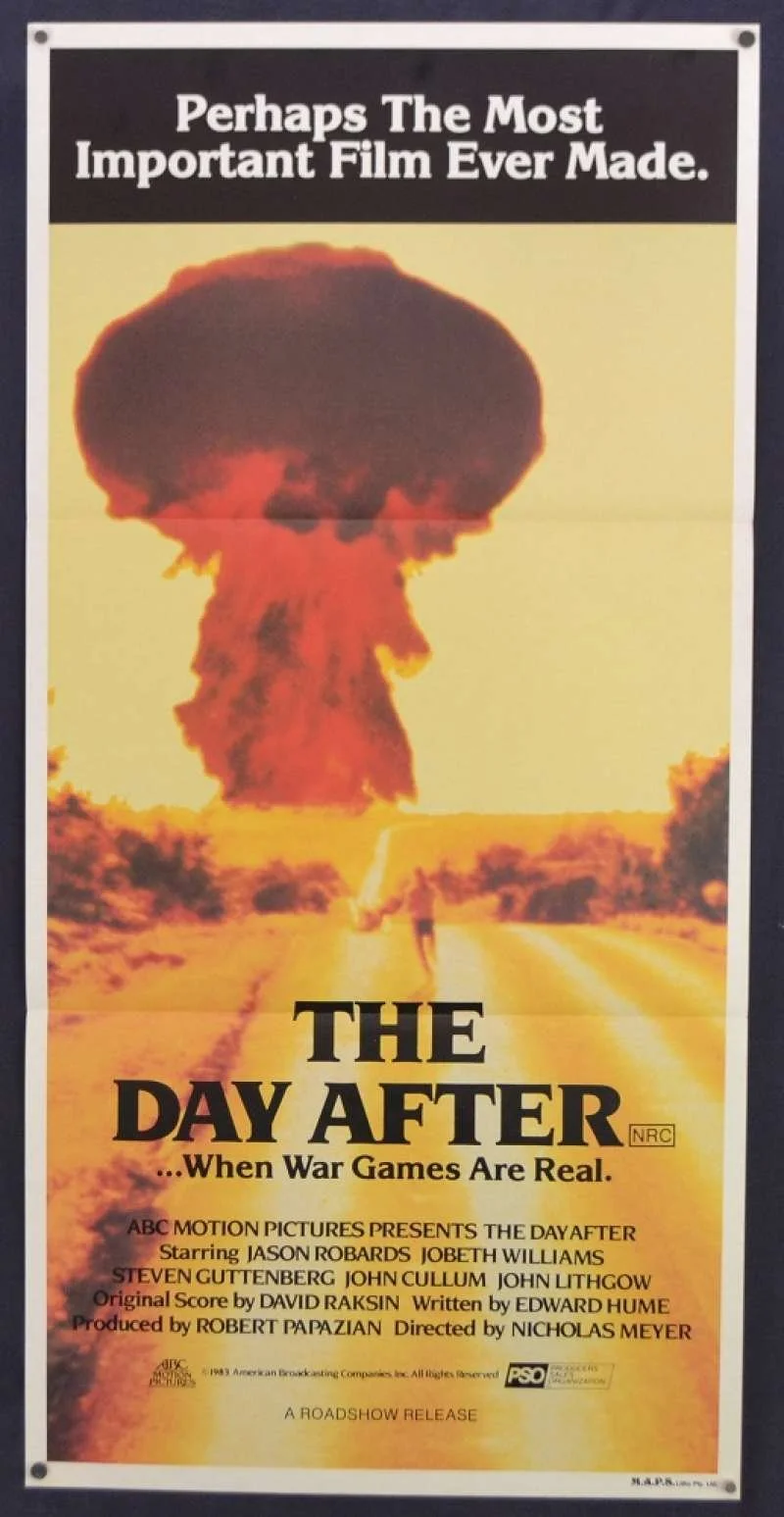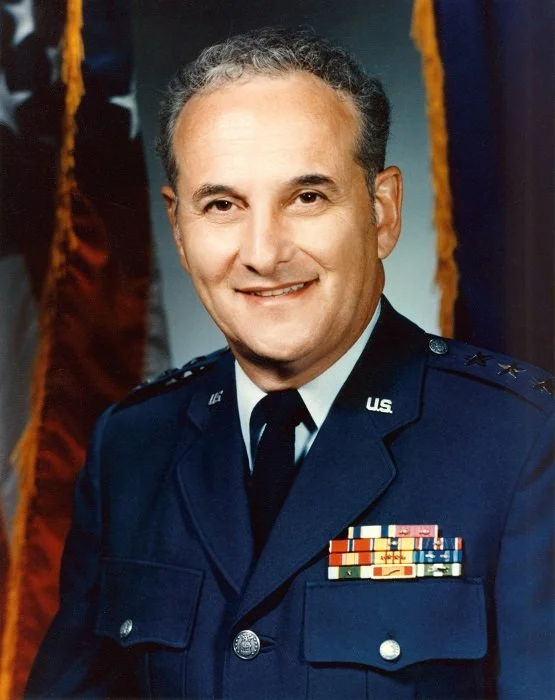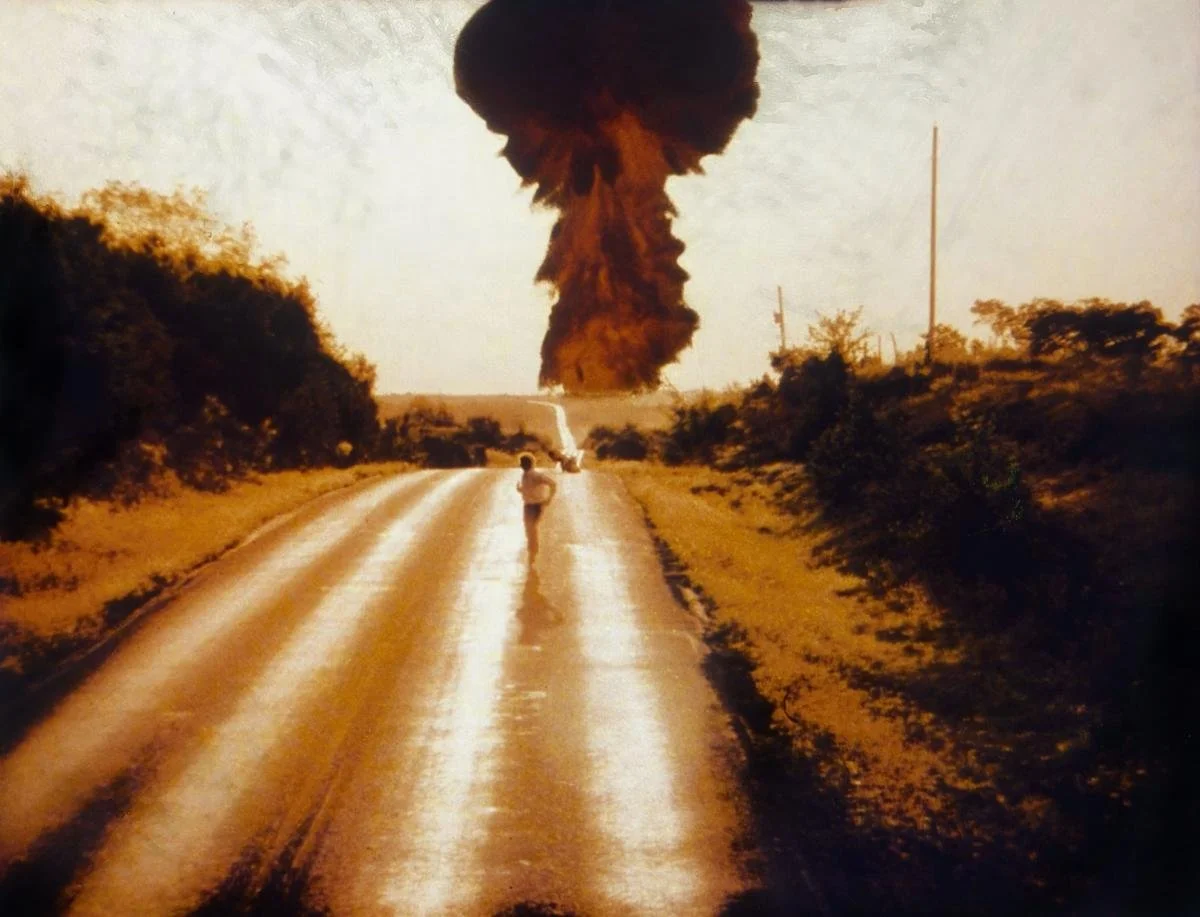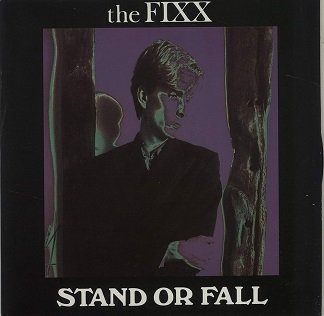40 Years Later: Remembering The Day After and the Fall of 1983.
Absolutely sobering.
This television movie made its impact on November 20, 1983.
Source: Bulletin of the Atomic Scientists; thebulletin.org
Prologue
Many of us remember when the movie WarGames hit theaters in June 1983. Later that Fall, the fear became worse as the world seemingly stood on the brink of apocalypse. These events began to affect our outlook, music, and culture. However, many years later, we learned that we actually were seconds away from total destruction on at least two separate occasions that memorable autumn…
“First of all, everyone made it through 1983, another truly memorable year, when ten-year-olds like me were often informed that red skies and mushroom clouds could soon appear on the horizon.”
- Woodard, Anthony. “There’s a big world out there, and remember, when one door closes, another opens... (Repost)”. Feb. 8, 2023
Stanislav Petrov: The Man Who Saved the World!
On September 26, 1983, during the Cold War, the nuclear early-warning radar of the Soviet Union reported the launch of one intercontinental ballistic missile with four more missiles behind it, from bases in the United States. These missile attack warnings were suspected to be false alarms by Stanislav Petrov, an engineer of the Soviet Air Defence Forces on duty at the command center of the early-warning system. He decided to wait for corroborating evidence—of which none arrived—rather than immediately relaying the warning up the chain-of-command. This decision is seen as having prevented a retaliatory nuclear attack against the United States and its NATO allies, which would likely have resulted in an escalation to a full-scale nuclear war. Investigation of the satellite warning system later determined that the system had indeed malfunctioned.
Source: Wikipedia.org
“In 1983, Soviet military officer Stanislav Petrov prevented what could have been a devastating nuclear war by trusting his gut instinct that the algorithm in his early-warning system wrongly sensed incoming missiles. In this case, we praise Petrov for choosing human judgment over the automated system in front of him. But what will happen as the AI algorithms deployed in the nuclear sphere become much more advanced, accurate, and difficult to understand? Will the next officer in Petrov’s position be more likely to trust the “smart” machine in front of him?”
“On the one hand, the Petrov incident, if it captures one simple point, it's the benefit of human judgment. One of the things that Petrov talks about is that when evaluating what to do in this situation, there was a lot of extra contextual information that he could bring to bear that would outside of what the computer system itself knew. The computer system knew that there had been some flashes that the Soviet satellite early warning system had picked up, that it interpreted it as missile launches, and that was it.”
Source: “Podcast: AI and Nuclear Weapons - Trust, Accidents, and New Risks with Paul Scharre and Mike Horowitz”. Future of Life Institute. September 27, 2018.
On November 8, 1983, World War III almost began.
This day is now acknowledged as one of most perilous of the Cold War. Able Archer 83 was an annual NATO exercise conducted in November 1983. The purpose for the command post exercise, like previous years, was to simulate a period of conflict escalation, culminating in the US military attaining a simulated DEFCON 1 coordinated nuclear attack. The five-day exercise, which involved NATO commands throughout Western Europe, was coordinated from the Supreme Headquarters Allied Powers Europe (SHAPE) headquarters in Casteau, Belgium. The 1983 exercise, which began on November 7, 1983, introduced several new elements not seen in previous years, including a new, unique format of coded communication, radio silences, and the participation of heads of government. This increase in realism, combined with tense relations between the United States and the Soviet Union and the anticipated arrival of Pershing II nuclear missiles in Europe, led some members of the Soviet Politburo and military to believe that Able Archer 83 was a ruse of war, obscuring preparations for a genuine nuclear first strike. In response, the Soviet Union readied their nuclear forces and placed air units in East Germany and Poland on alert. The Soviet 4th Air Army began loading nuclear warheads onto combat planes in preparation for war. The apparent threat of nuclear war ended when U. S. Lieutenant General Leonard H. Perroots advised against responding to the Warsaw Pact military activity, which ended with the conclusion of the exercise on November 11. The exercise attracted public attention in 2015 when the President's Intelligence Advisory Board 1990 report on the exercise was declassified.
Source: Wikipedia.org
Early in the next decade, with new leadership on both sides, détente had evaporated. After taking office in 1981, Reagan matched his campaign rhetoric by initiating a doubling of the defense budget. Soviet leader Yuri Andropov, who assumed power the following year, came to the job after heading the KGB, where he initiated Operation RYaN, whose name is an acronym describing a sudden nuclear attack. “The main objective of our intelligence service is not to miss the military preparations of the enemy … for a nuclear strike,” Andropov said in 1981. Operation RYaN lent itself to confirmation bias, with many routine activities—such as official visits or blood drives—feeding fears of war. And when it came to looking for signs of imminent attack, Able Archer fit the bill. It was a vicious circle. The Soviets refused to believe the Americans were bluffing; the Americans, meanwhile, suspected the Soviets were bluffing about not thinking the Americans were bluffing. As the Able Archer scenario intensified, the head of the Soviet air forces ordered a state of readiness that “included preparations for immediate use of nuclear weapons,” according to later-declassified sources referenced in a memorandum by Lieutenant General Leonard Perroots, then the Air Force’s assistant chief of staff for intelligence in Europe. During the exercise, analysts concluded that at least one squadron “was loading a munitions configuration that they had never actually loaded before.
Source: Uenuma, Francine. “The 1983 Military Drill That Nearly Sparked Nuclear War With the Soviets”. Smithsonian Magazine. Apr. 27, 2022
Leonard Harry Perroots, Sr., USAF (April 24, 1933 – January 29, 2017)
Photo Credit: U.S. Air Force - Public Domain, Source: Wikipedia.org
“Had Perroots mirrored the Soviets and escalated the situation, the War Scare could conceivably have become a war,” Nate Jones wrote last year in “Able Archer 83: The Secret History of the NATO Exercise That Almost Triggered Nuclear War.” He added, “Fortunately, Perroots trusted his gut, and Able Archer 83 ended without nuclear incident.”
- “Leonard Perroots, General Who Defused Nuclear Crisis With Soviets, Dies at 83”, Roberts, Sam - The New York Times, February 10, 2017.
General Perroots went on to direct the Defense Intelligence Agency from 1985 to 1988 under President Reagan. He also oversaw efforts to find American military veterans still missing in action in Southeast Asia more than a decade after the Vietnam War ended.
Trust your gut…
At the time, Perroots chose to continue monitoring development and not escalate in kind. (His prudent inaction has drawn comparisons to Soviet Lieutenant Colonel Stanislav Petrov, who correctly interpreted a false alarm of nuclear attack that September.) In his memorandum, Perroots outlined a “potentially disastrous situation,” one that he found even more alarming after Oleg Gordievsky, a high-level KGB officer who served as a double agent for the British, revealed that the Soviet security agency believed Able Archer would serve as an ideal “cover” for an attack. After the exercise, with the benefit of hindsight, the PFIAB report called Perroots’ patience a “fortuitous, if ill-informed, decision.”
“We now know how nervous the [Soviet] leadership became, ... [putting] the entire [state] arsenal with its 11,000 warheads on to maximum combat alert,” writes Downing in his book. He describes a seriously ill Andropov conferring with military leaders at a clinic outside of Moscow as the exercise proceeded apace, capturing the essence of the problem that was at the crux of Able Archer and the “war scare” as a whole: “It was impossible for satellites to pick up any insight into the state of paranoia in the Soviet leadership.”
Source: Uenuma, Francine. “The 1983 Military Drill That Nearly Sparked Nuclear War With the Soviets”. Smithsonian Magazine. Apr. 27, 2022
“1983: The Brink of Apocalypse” is a well-produced documentary that detailed these precarious times. The documentary archive also consists of transcripts of 31 interviews concerning Able Archer and the related events of late-1983.
The Day After
My hometown (Kansas City) was literally at “Ground Zero” for this movie and the discussions that followed…
A scene from the film, in which a nuclear weapon detonates just outside of Kansas City; surreal and terrifying…
The Day After was an American television film that first aired on November 20, 1983 on the ABC television network. More than 100 million people, in nearly 39 million households, watched the film during its initial broadcast. With a 46 rating and a 62% share of the viewing audience during the initial broadcast, the film was the seventh-highest-rated non-sports show until then, and it set a record as the highest-rated television film in history… On its original broadcast, on Sunday, November 20, 1983, John Cullum, who played Jim Dahlberg in the movie, warned viewers before the film was premiered that the film contains graphic and disturbing scenes and encouraged parents who had young children watching to watch together and discuss the issues of nuclear warfare. ABC and local TV affiliates opened 1-800 hotlines with counselors standing by. There were no commercial breaks after the nuclear attack scenes. ABC then aired a live debate on Viewpoint, ABC's occasional discussion program hosted by Nightline's Ted Koppel, featuring the scientist Carl Sagan, former Secretary of State Henry Kissinger, Elie Wiesel, former Secretary of Defense Robert McNamara, General Brent Scowcroft, and the commentator William F. Buckley Jr. Sagan argued against nuclear proliferation, but Buckley promoted the concept of nuclear deterrence. Sagan described the arms race in the following terms: "Imagine a room awash in gasoline, and there are two implacable enemies in that room. One of them has nine thousand matches, the other seven thousand matches. Each of them is concerned about who's ahead, who's stronger."The film and its subject matter were prominently featured in the news media both before and after the broadcast, including on such covers as TIME, Newsweek, U.S. News & World Report, and TV Guide.
Source: Wikipedia.org
“Thank you ABC. Those “x-ray-like” skeletons in your program The Day After are burned in my memory.”
- Woodard, Anthony. “There’s a big world out there, and remember, when one door closes, another opens... (Repost)”. Feb. 8, 2023
These scenes caused a few nightmares for then ten-year-olds like me. The fact that I, along with my friends and family (and dog), could perish in an instant, was frightening and remained on my mind for some time. 1983 was when I became “sentient”; aware of current events and geopolitics.
Below was the movie’s ending disclaimer:
“The catastrophic events you have just witnessed are, in all likelihood, less severe than the destruction that would actually occur in the event of a full nuclear strike against the United States. It is hoped that the images of this film will inspire the nations of this earth, their peoples and leaders, to find the means to avert the fateful day.”
Much of the music reflected (still reflects) the times…
While the song “Invisible Sun” and its video shown below were not about nuclear war or nuclear accidents, the song and the video’s imagery captured our collective mood surrounding the topics of war and poverty in general.
“The song's lyrics stem from songwriter Sting's pondering how people living in war-torn and/or impoverished countries find the will to go on living, and despite the dark music and often morbid lyrical statements, the song carries an uplifting and optimistic message.”
Source: Wikipedia.org
The more things change, the more they stay the same…
The English version of “99 Luftballons” (99 Red Balloons) by Nena retains the spirit of the original narrative, but many of the lyrics are translated poetically rather than being directly translated: red helium balloons are casually released by the civilian singer (narrator) with her unnamed friend into the sky and are mistakenly registered by a faulty early warning system as enemy contacts, resulting in panic and eventually nuclear war, with the end of the song near-identical to the end of the original German version. From the outset Nena and other members of the band expressed disapproval of the English version of the song, "99 Red Balloons". In March 1984, the band's keyboardist and song co-writer Uwe Fahrenkrog Petersen said, "We made a mistake there. I think the song loses something in translation and even sounds silly." [Unfortunately, in 2023, such a premise no longer sounds silly…]
Source: Wikipedia.org
2023 Chinese balloon incident
From January 28 to February 4, 2023, a Chinese-operated high-altitude balloon was spotted in North American airspace, including Alaska, western Canada, and the contiguous United States. On February 4, the U.S. Air Force shot down the balloon over U.S. territorial waters off the coast of South Carolina, on the order of U.S. President Joe Biden. It was shot down by a U.S. F-22 Raptor. Debris from the wreckage was recovered and sent to the FBI Laboratory in Quantico, Virginia, for analysis.
The American and Canadian militaries announced that the balloon was for surveillance, while the Chinese government maintained it was a civilian (mainly meteorological) airship that had been blown off course. The U.S. said that the balloon was capable of geolocating electronic communications and carried intelligence surveillance equipment inconsistent with that of a weather balloon. It added that similar Chinese spy balloons have flown over more than 40 nations. Analysts said that its flight path and structural characteristics were dissimilar from those of a typical weather balloon. American officials later disclosed that they had been tracking the Chinese balloon since it was launched from Hainan. Its original destinations were likely Guam and Hawaii, but prevailing winds blew it off course and across North America.
The incident increased U.S.–China tensions. The United States called the balloon's presence a violation of its sovereignty, and its Secretary of State Antony Blinken postponed a long-awaited diplomatic visit to Beijing. Canada summoned the Chinese ambassador in response to the incident. On February 2, a similar Chinese balloon was observed flying over Latin America.
In the United States, three other high-altitude objects, over Northern Alaska (February 10), Yukon (February 11), and Lake Huron (February 11–12) respectively, were detected and subsequently shot down; later assessment said they had no relations to China. On February 14, the US government announced that the latter three high-altitude objects shot down over the North America were likely private entities... Further analysis and debris collections were underway. The four AIM-9X missiles expended for shooting down the three objects cost at least $1.5 million.
In April, The Washington Post reported additional information on the February and other Chinese spy balloons following the 2023 Pentagon document leaks. According to the Post, its information came from a trove of classified files on Discord that were previously unreported. They include U.S. assessment of the downed balloon's power generation capability (up to 10,000 watts), which would be sufficient to operate synthetic-aperture radar equipment if carried onboard, and how parts of the Chinese government were surprised by the balloon's North American incursion, judging from intercepted communications. U.S. intelligence had been aware of four other similar balloons, one of which had flown over a Nimitz carrier strike group in western Pacific, while another had crashed in the South China Sea. The documents did not date those incidents. The Pentagon and the Office of National Intelligence declined to comment.
Source: Wikipedia.org
Clearest image of the “weather” balloon taken over Missouri…
And… according to NBC News, on May 1, 2023, the U.S. military was “tracking another mysterious balloon [near Hawaii]. The military has determined that it poses no threat to aerial traffic or national security, but it's not clear what it is or whom it belongs to, officials said…”
99 red balloons
Floating in the summer sky
Panic bells, it's red alert
There's something here from somewhere else
The war machine springs to life
Opens up one eager eye
Focusing it on the sky
The 99 red balloons go by
Lyrics from “99 Red Balloons” by Nena
Dr. Russell Oakes (Jason Robards):
“What’s going on? Do you understand what’s going on in this world?”
Dr. Landowska (George Petrie):
“Yeah. Stupidity. Has a habit of getting its way.”
Quote(s) from The Day After






